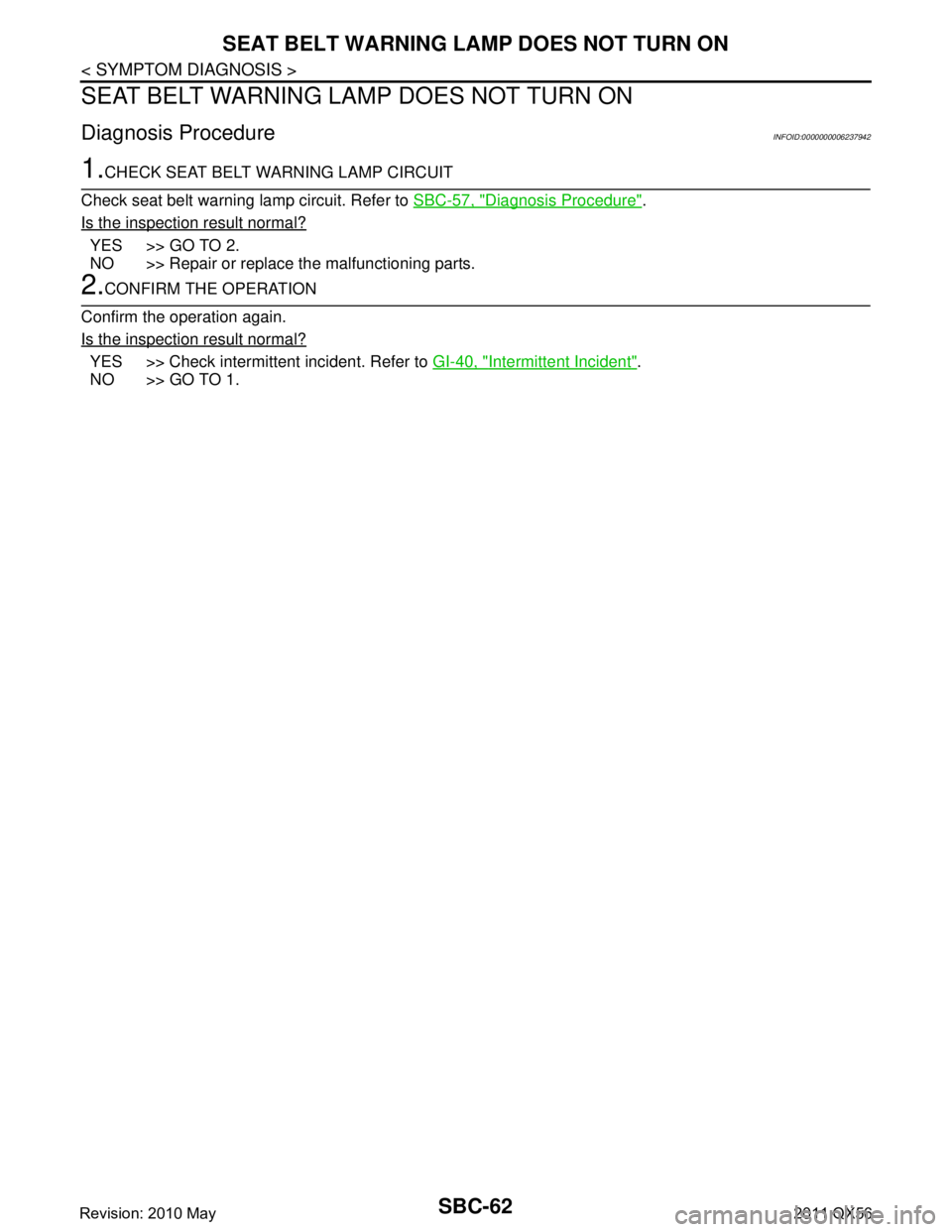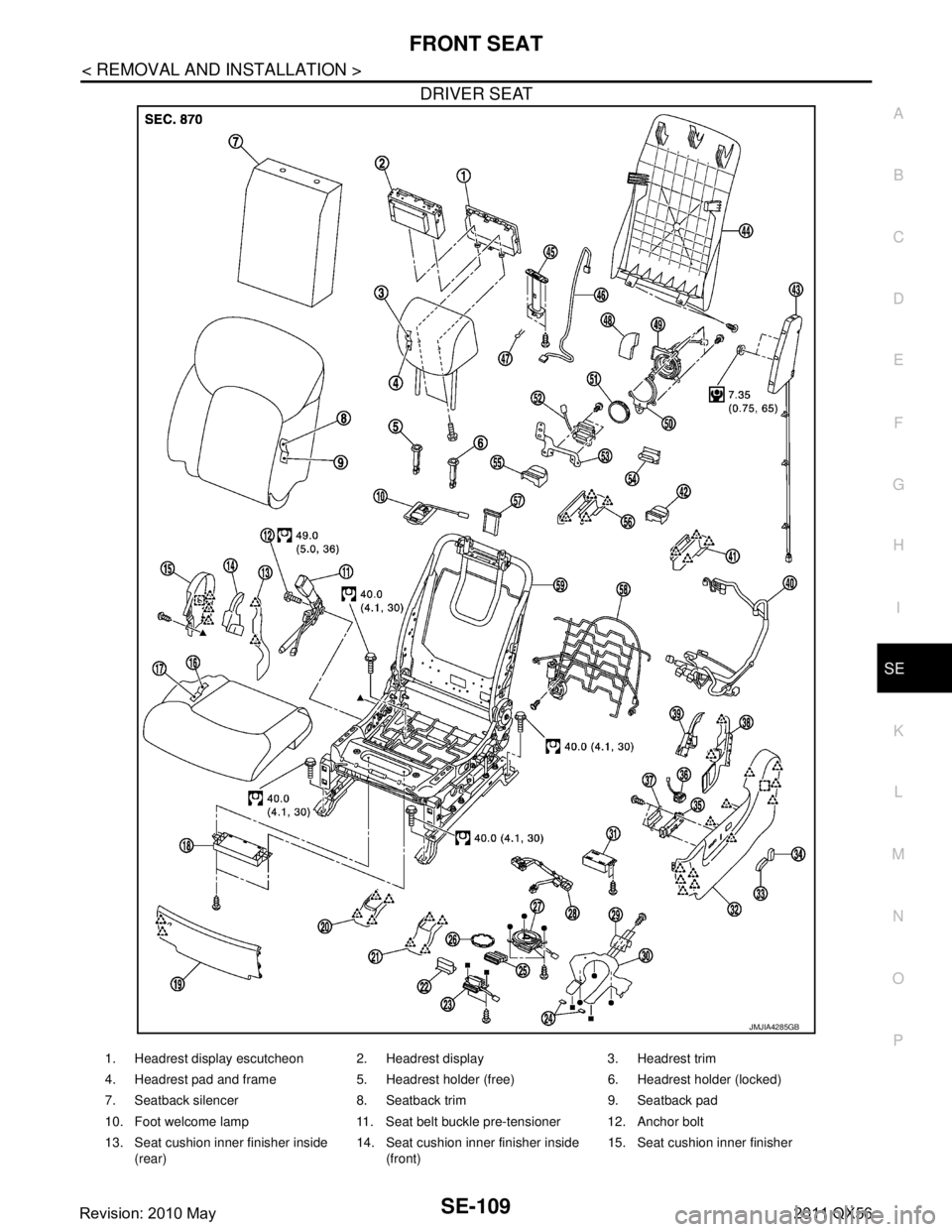2011 INFINITI QX56 belt
[x] Cancel search: beltPage 4359 of 5598

SBC-62
< SYMPTOM DIAGNOSIS >
SEAT BELT WARNING LAMP DOES NOT TURN ON
SEAT BELT WARNING LAMP DOES NOT TURN ON
Diagnosis ProcedureINFOID:0000000006237942
1.CHECK SEAT BELT WARNING LAMP CIRCUIT
Check seat belt warning lamp circuit. Refer to SBC-57, "
Diagnosis Procedure".
Is the inspection result normal?
YES >> GO TO 2.
NO >> Repair or replace the malfunctioning parts.
2.CONFIRM THE OPERATION
Confirm the operation again.
Is the inspection result normal?
YES >> Check intermittent incident. Refer to GI-40, "Intermittent Incident".
NO >> GO TO 1.
Revision: 2010 May2011 QX56
Page 4361 of 5598

SCS-1
SUSPENSION
C
DF
G H
I
J
K L
M
SECTION SCS
A
B
SCS
N
O PCONTENTS
SUSPENSION CONTROL SYSTEM
HBMC
PRECAUTION ................ ...............................
4
PRECAUTIONS .............................................. .....4
Precaution for Supplemental Restraint System
(SRS) "AIR BAG" and "SEAT BELT PRE-TEN-
SIONER" ............................................................. ......
4
Precaution Necessary for Steering Wheel Rota-
tion after Battery Disconnect .....................................
4
Precaution for Procedure without Cowl Top Cover ......5
Precaution for Hydraulic Body-Motion Control
System ......................................................................
5
PREPARATION ............................................6
PREPARATION .............................................. .....6
Special Service Tools .......................................... ......6
Commercial Service Tools ........................................6
SYSTEM DESCRIPTION ..............................7
DESCRIPTION ............................................... .....7
Description .......................................................... ......7
COMPONENT PARTS ........................................8
Component Parts Location .................................. ......8
Component Description .............................................8
STRUCTURE AND OPERATION ........................9
Hydraulic Body-Motion Control System .............. ......9
Shock Absorber .........................................................9
PPMU ......................................................................10
Accumulator ............................................................11
PPMU Pipe ..............................................................11
SYSTEM .............................................................12
System Diagram .................................................. ....12
System Description .................................................12
Component Description ...........................................14
BASIC INSPECTION ...................................15
CHECK SYSTEM PRESSURE .........................15
Work Procedure ................................................... ....15
PRESSURE REDUCING METHOD ..................17
Work Procedure .......................................................17
AIR BLEEDING METHOD ................................18
Work Procedure .......................................................18
CHECK INTERNAL LEAKAGE ........................20
Work Procedure .......................................................20
CHECK FOR MALFUNCTION ..........................22
Work Procedure .......................................................22
CHECK SHOCK ABSORBER FOR MAL-
FUNCTION ....................................... .................
24
Work Procedure ................................................... ....24
CHECK ORIFICE FOR CLOGGING .................27
Work Procedure .......................................................27
SYMPTOM DIAGNOSIS ..............................29
DIFFERENCE IN APPEARANCE .....................29
Description ........................................................... ....29
Inspection Procedure ...............................................29
LARGE ROLL ANGLE ......................................30
Description ...............................................................30
Inspection Procedure ...............................................30
REMOVAL AND INSTALLATION ...............31
HYDRAULIC BODY-MOTION CONTROL
SYSTEM ............................................................
31
Hydraulic Piping ................................................... ....31
FRONT TUBE ASSEMBLY .......................................31
FRONT TUBE ASSEMBLY : Exploded View ...... ....32
FRONT TUBE ASSEMBLY : Removal and Instal-
lation ........................................................................
32
FRONT TUBE ASSEMBLY : Inspection ..................34
Revision: 2010 May2011 QX56
Page 4362 of 5598

SCS-2
ACCUMULATOR ......................................................34
ACCUMULATOR : Exploded View .........................35
ACCUMULATOR : Removal and Installation ..........35
ACCUMULATOR : Inspection ................................38
ACCUMULATOR : Disposal ...................................38
PPMU, MIDDLE TUBE ASSEMBLY, PPMU PIPE ...38
PPMU, MIDDLE TUBE ASSEMBLY, PPMU PIPE
: Exploded View ......................................................
39
PPMU, MIDDLE TUBE ASSEMBLY, PPMU PIPE
: Removal and Installation ......................................
39
PPMU, MIDDLE TUBE ASSEMBLY, PPMU PIPE
: Inspection .............................................................
43
PPMU, MIDDLE TUBE ASSEMBLY, PPMU PIPE
: Disposal ................................................................
43
REAR TUBE ASSEMBLY ...................................... ...43
REAR TUBE ASSEMBLY : Exploded View ............44
REAR TUBE ASSEMBLY : Removal and Installa-
tion ....................................................................... ...
44
REAR TUBE ASSEMBLY : Inspection ...................46
AIR LEVELIZER CONTROL SYSTEM
PRECAUTION ....... ....................... ...............
47
PRECAUTIONS .............................................. ...47
Precaution for Supplemental Restraint System
(SRS) "AIR BAG" and "SEAT BELT PRE-TEN-
SIONER" .............................................................. ...
47
Precaution Necessary for Steering Wheel Rota-
tion after Battery Disconnect ..................................
47
Precaution for Procedure without Cowl Top Cover ...48
Precaution for Air Levelizer Control System ...........48
SYSTEM DESCRIPTION ............................49
DESCRIPTION ................................................ ...49
Description ........................................................... ...49
COMPONENT PARTS .......................................50
Component Parts Location .................................. ...50
Component Description ..........................................50
Air Levelizer Control Module ..................................51
Vehicle Height Sensor ............................................51
Air Compressor .......................................................51
Air Compressor Relay ............................................51
CK SUSP Indicator Lamp .......................................51
STRUCTURE AND OPERATION ......................52
Rear Shock Absorber .......................................... ...52
Vehicle Height Sensor ............................................53
SYSTEM .......................................................... ...54
System Diagram .................................................. ...54
System Description .................................................54
Fail-safe ..................................................................55
DIAGNOSIS SYSTEM (AIR LEVELIZER
CONTROL MODULE) ........................................
56
CONSULT-III Function ........................................ ...56
ECU DIAGNOSIS INFORMATION .............58
AIR LEVELIZER CONTROL MODULE .......... ...58
Reference Value .................................................. ...58
Fail-safe ..................................................................59
DTC Inspection Priority Chart .................................59
DTC Index ...............................................................59
WIRING DIAGRAM ....................................61
AIR LEVELIZER CONTROL SYSTEM ........... ...61
Wiring Diagram .................................................... ...61
BASIC INSPECTION ..................................65
DIAGNOSIS AND REPAIR WORKFLOW ...... ...65
Work Flow ............................................................ ...65
Diagnostic Work Sheet ...........................................66
STANDARD VEHICLE HEIGHT SETTING .......67
Description ........................................................... ...67
Work Procedure ......................................................67
DTC/CIRCUIT DIAGNOSIS ........................69
C1801 VHCL HEIGHT SENSOR .................... ...69
DTC Logic ............................................................ ...69
Diagnosis Procedure ..............................................69
Component Inspection ............................................70
C1802 AIR SUS COMPRS RELAY ...................72
DTC Logic ............................................................ ...72
Diagnosis Procedure ..............................................72
C1803 AIR SUSPENSION EXH SOL ................74
DTC Logic ............................................................ ...74
Diagnosis Procedure ..............................................74
Component Inspection ............................................75
C1804 VHCL HEIGHT ADJ UP .........................77
DTC Logic ............................................................ ...77
Diagnosis Procedure ..............................................77
Component Inspection (Air Compressor Relay) .....79
Component Inspection (Air Compressor) ............. ...79
C1805 VHCL HEIGHT ADJ DOWN ...................80
DTC Logic ............................................................ ...80
Diagnosis Procedure ..............................................80
C1806 VHCL HEIGHT SEN FIX ........................81
DTC Logic ............................................................ ...81
Diagnosis Procedure ...............................................81
C1807 VHCL HEIGHT SEN VOLT ....................82
DTC Logic ............................................................ ...82
Diagnosis Procedure ..............................................82
C1808 AIR SUS COMPRS FNCTN ...................84
DTC Logic ............................................................ ...84
Diagnosis Procedure ..............................................84
U1000 CAN COMM CIRCUIT ............................87
Revision: 2010 May2011 QX56
Page 4364 of 5598
![INFINITI QX56 2011 Factory Service Manual
SCS-4
< PRECAUTION >[HBMC]
PRECAUTIONS
PRECAUTION
PRECAUTIONS
Precaution for Supplemental Restraint S
ystem (SRS) "AIR BAG" and "SEAT BELT
PRE-TENSIONER"
INFOID:0000000006256134
The Supplemental Res INFINITI QX56 2011 Factory Service Manual
SCS-4
< PRECAUTION >[HBMC]
PRECAUTIONS
PRECAUTION
PRECAUTIONS
Precaution for Supplemental Restraint S
ystem (SRS) "AIR BAG" and "SEAT BELT
PRE-TENSIONER"
INFOID:0000000006256134
The Supplemental Res](/manual-img/42/57033/w960_57033-4363.png)
SCS-4
< PRECAUTION >[HBMC]
PRECAUTIONS
PRECAUTION
PRECAUTIONS
Precaution for Supplemental Restraint S
ystem (SRS) "AIR BAG" and "SEAT BELT
PRE-TENSIONER"
INFOID:0000000006256134
The Supplemental Restraint System such as “A IR BAG” and “SEAT BELT PRE-TENSIONER”, used along
with a front seat belt, helps to reduce the risk or severi ty of injury to the driver and front passenger for certain
types of collision. This system includes seat belt switch inputs and dual stage front air bag modules. The SRS
system uses the seat belt switches to determine the front air bag deployment, and may only deploy one front
air bag, depending on the severity of a collision and w hether the front occupants are belted or unbelted.
Information necessary to service the system safely is included in the “SRS AIR BAG” and “SEAT BELT” of this
Service Manual.
WARNING:
• To avoid rendering the SRS inopera tive, which could increase the risk of personal injury or death in
the event of a collision that would result in air bag inflation, all maintenance must be performed by
an authorized NISS AN/INFINITI dealer.
Improper maintenance, including in correct removal and installation of the SRS, can lead to personal
injury caused by unintent ional activation of the system. For re moval of Spiral Cable and Air Bag
Module, see the “SRS AIR BAG”.
Do not use electrical test equipmen t on any circuit related to the SRS unless instructed to in this
Service Manual. SRS wiring harnesses can be identi fied by yellow and/or orange harnesses or har-
ness connectors.
PRECAUTIONS WHEN USING POWER TOOLS (AIR OR ELECTRIC) AND HAMMERS
WARNING:
When working near the Air Bag Diagnosis Sensor Unit or other Air Bag System sensors with the ignition ON or engine running, DO NOT use air or electric power tools or strike near the sensor(s)
with a hammer. Heavy vibration could activate the sensor(s) and deploy the air bag(s), possibly
causing serious injury.
When using air or electric power tools or hammers , always switch the ignition OFF, disconnect the
battery, and wait at least 3 minu tes before performing any service.
Precaution Necessary for Steering W heel Rotation after Battery Disconnect
INFOID:0000000006256136
NOTE:
Before removing and installing any control units, first tu rn the push-button ignition switch to the LOCK posi-
tion, then disconnect bot h battery cables.
After finishing work, confirm that all control unit connectors are connected properly, then re-connect both
battery cables.
Always use CONSULT-III to perform self-diagnosis as a part of each function inspection after finishing work.
If a DTC is detected, perform trouble diagnos is according to self-diagnosis results.
For vehicle with steering lock unit, if the battery is disconnected or discharged, the steering wheel will lock and
cannot be turned.
If turning the steering wheel is required with the bat tery disconnected or discharged, follow the operation pro-
cedure below before starting the repair operation.
OPERATION PROCEDURE
1. Connect both battery cables. NOTE:
Supply power using jumper cables if battery is discharged.
2. Turn the push-button ignition switch to ACC position. (At this time, the steering lock will be released.)
3. Disconnect both battery cables. The steering lock wi ll remain released with both battery cables discon-
nected and the steering wheel can be turned.
4. Perform the necessary repair operation.
Revision: 2010 May2011 QX56
Page 4407 of 5598
![INFINITI QX56 2011 Factory Service Manual
PRECAUTIONSSCS-47
< PRECAUTION > [AIR LEVELIZER CONTROL SYSTEM]
C
D
F
G H
I
J
K L
M A
B
SCS
N
O P
PRECAUTION
PRECAUTIONS
Precaution for Supplemental Restraint System (SRS) "AIR BAG" and "SEAT BELT
INFINITI QX56 2011 Factory Service Manual
PRECAUTIONSSCS-47
< PRECAUTION > [AIR LEVELIZER CONTROL SYSTEM]
C
D
F
G H
I
J
K L
M A
B
SCS
N
O P
PRECAUTION
PRECAUTIONS
Precaution for Supplemental Restraint System (SRS) "AIR BAG" and "SEAT BELT](/manual-img/42/57033/w960_57033-4406.png)
PRECAUTIONSSCS-47
< PRECAUTION > [AIR LEVELIZER CONTROL SYSTEM]
C
D
F
G H
I
J
K L
M A
B
SCS
N
O P
PRECAUTION
PRECAUTIONS
Precaution for Supplemental Restraint System (SRS) "AIR BAG" and "SEAT BELT
PRE-TENSIONER"
INFOID:0000000006256135
The Supplemental Restraint System such as “A IR BAG” and “SEAT BELT PRE-TENSIONER”, used along
with a front seat belt, helps to reduce the risk or severi ty of injury to the driver and front passenger for certain
types of collision. This system includes seat belt switch inputs and dual stage front air bag modules. The SRS
system uses the seat belt switches to determine the front air bag deployment, and may only deploy one front
air bag, depending on the severity of a collision and whether the front occupants are belted or unbelted.
Information necessary to service the system safely is included in the “SRS AIR BAG” and “SEAT BELT” of this
Service Manual.
WARNING:
To avoid rendering the SRS inoper ative, which could increase the risk of personal injury or death in
the event of a collision that would result in air ba g inflation, all maintenance must be performed by
an authorized NISSAN/INFINITI dealer.
Improper maintenance, including in correct removal and installation of the SRS, can lead to personal
injury caused by unintentional act ivation of the system. For removal of Spiral Cable and Air Bag
Module, see the “SRS AIR BAG”.
Do not use electrical test equipm ent on any circuit related to the SRS unless instructed to in this
Service Manual. SRS wiring harnesses can be identi fied by yellow and/or orange harnesses or har-
ness connectors.
PRECAUTIONS WHEN USING POWER TOOLS (AIR OR ELECTRIC) AND HAMMERS
WARNING:
When working near the Air Bag Diagnosis Sensor Unit or other Air Bag System sensors with the
ignition ON or engine running, DO NOT use air or electric power tools or strike near the sensor(s)
with a hammer. Heavy vibration could activate the sensor(s) and deploy the air bag(s), possibly
causing serious injury.
When using air or electric power tools or hammers , always switch the ignition OFF, disconnect the
battery, and wait at least 3 minutes before performing any service.
Precaution Necessary for Steering Wh eel Rotation after Battery Disconnect
INFOID:0000000006256137
NOTE:
Before removing and installing any control units, first tu rn the push-button ignition switch to the LOCK posi-
tion, then disconnect both battery cables.
After finishing work, confirm that all control unit connectors are connected properly, then re-connect both
battery cables.
Always use CONSULT-III to perform self-diagnosis as a part of each function inspection after finishing work.
If a DTC is detected, perform trouble diagnos is according to self-diagnosis results.
For vehicle with steering lock unit, if the battery is disconnected or discharged, the steering wheel will lock and
cannot be turned.
If turning the steering wheel is required with the batte ry disconnected or discharged, follow the operation pro-
cedure below before starting the repair operation.
OPERATION PROCEDURE
1. Connect both battery cables. NOTE:
Supply power using jumper cables if battery is discharged.
2. Turn the push-button ignition switch to ACC position. (At this time, the steering lock will be released.)
3. Disconnect both battery cables. The steering lock wil l remain released with both battery cables discon-
nected and the steering wheel can be turned.
4. Perform the necessary repair operation.
Revision: 2010 May2011 QX56
Page 4460 of 5598

SE-1
BODY INTERIOR
C
DE
F
G H
I
K L
M
SECTION SE
A
B
SE
N
O P
CONTENTS
SEAT
PRECAUTION ................ ...............................4
PRECAUTIONS .............................................. .....4
Precaution for Supplemental Restraint System
(SRS) "AIR BAG" and "SEAT BELT PRE-TEN-
SIONER" ............................................................. ......
4
Service Notice ...........................................................4
Precaution for Work ..................................................4
PREPARATION ............................................6
PREPARATION .............................................. .....6
Commercial Service Tool .................................... ......6
CLIP LIST ............................................................7
Clip List ............................................................... ......7
SYSTEM DESCRIPTION ..............................8
COMPONENT PARTS ................................... .....8
POWER SEAT SYSTEM .............................................8
POWER SEAT SYSTEM : Component Parts Lo-
cation ................................................................... ......
8
POWER SEAT SYSTEM : Component Descrip-
tion ...................................................................... ......
8
LUMBAR SUPPORT SYSTEM .............................. ......8
LUMBAR SUPPORT SYSTEM : Component
Parts Location ..................................................... ......
9
LUMBAR SUPPORT SYSTEM : Component De-
scription .....................................................................
9
SECOND SEAT POWER UNLOCK SYSTEM ....... ......9
SECOND SEAT POWER UNLOCK SYSTEM :
Component Parts Location ......................................
10
SECOND SEAT POWER UNLOCK SYSTEM :
Component Description ...........................................
10
THIRD SEAT SEATBACK POWER FOLDING
SYSTEM ................................................................ ....
10
THIRD SEAT SEATBACK POWER FOLDING
SYSTEM : Component Parts Location ....................
11
THIRD SEAT SEATBACK POWER FOLDING
SYSTEM : Component Description ..................... ....
11
FRONT HEATED SEAT SYSTEM ......................... ....12
FRONT HEATED SEAT SYSTEM : Component
Parts Location ..........................................................
12
FRONT HEATED SEAT SYSTEM : Component
Description ...............................................................
12
SECOND HEATED SEAT SYSTEM ...................... ....13
SECOND HEATED SEAT SYSTEM : Component
Parts Location ..........................................................
13
SECOND HEATED SEAT SYSTEM : Component
Description ...............................................................
13
CLIMATE CONTROLLED SEAT SYSTEM ...............13
CLIMATE CONTROLLED SEAT SYSTEM : Com-
ponent Parts Location .......................................... ....
14
CLIMATE CONTROLLED SEAT SYSTEM : Com-
ponent Description ...................................................
14
SYSTEM ............................................................16
POWER SEAT SYSTEM ....... .....................................16
POWER SEAT SYSTEM : Syst em Description .......16
LUMBAR SUPPORT SYSTEM .............................. ....16
LUMBAR SUPPORT SYSTEM : System Descrip-
tion ...........................................................................
16
SECOND SEAT POWER UNLOCK SYSTEM ...........16
SECOND SEAT POWER UNLOCK SYSTEM :
System Description .............................................. ....
16
THIRD SEAT SEATBACK POWER FOLDING
SYSTEM .....................................................................
16
THIRD SEAT SEATBACK POWER FOLDING
SYSTEM : System Description ............................ ....
16
FRONT HEATED SEAT SYSTEM ......................... ....16
FRONT HEATED SEAT SYSTEM : System De-
scription ...................................................................
16
SECOND HEATED SEAT SYSTEM ...................... ....16
Revision: 2010 May2011 QX56
Page 4463 of 5598

SE-4
< PRECAUTION >
PRECAUTIONS
PRECAUTION
PRECAUTIONS
Precaution for Supplemental Restraint System (SRS) "AIR BAG" and "SEAT BELT
PRE-TENSIONER"
INFOID:0000000006237842
The Supplemental Restraint System such as “A IR BAG” and “SEAT BELT PRE-TENSIONER”, used along
with a front seat belt, helps to reduce the risk or severi ty of injury to the driver and front passenger for certain
types of collision. This system includes seat belt switch inputs and dual stage front air bag modules. The SRS
system uses the seat belt switches to determine the front air bag deployment, and may only deploy one front
air bag, depending on the severity of a collision and w hether the front occupants are belted or unbelted.
Information necessary to service the system safely is included in the “SRS AIR BAG” and “SEAT BELT” of this
Service Manual.
WARNING:
• To avoid rendering the SRS inopera tive, which could increase the risk of personal injury or death in
the event of a collision that would result in air bag inflation, all maintenance must be performed by
an authorized NISS AN/INFINITI dealer.
Improper maintenance, including in correct removal and installation of the SRS, can lead to personal
injury caused by unintent ional activation of the system. For re moval of Spiral Cable and Air Bag
Module, see the “SRS AIR BAG”.
Do not use electrical test equipmen t on any circuit related to the SRS unless instructed to in this
Service Manual. SRS wiring harnesses can be identi fied by yellow and/or orange harnesses or har-
ness connectors.
PRECAUTIONS WHEN USING POWER TOOLS (AIR OR ELECTRIC) AND HAMMERS
WARNING:
When working near the Air Bag Diagnosis Sensor Unit or other Air Bag System sensors with the ignition ON or engine running, DO NOT use air or electric power tools or strike near the sensor(s)
with a hammer. Heavy vibration could activate the sensor(s) and deploy the air bag(s), possibly
causing serious injury.
When using air or electric power tools or hammers , always switch the ignition OFF, disconnect the
battery, and wait at least 3 minu tes before performing any service.
Service NoticeINFOID:0000000006217352
When removing or installing various parts, place a cloth or padding onto the vehicle body to prevent
scratches.
Handle trim, molding, instruments, grille, etc. carefull y during removing or installing. Be careful not to oil or
damage them.
Apply sealing compound where necessary when installing parts.
When applying sealing compound, be careful that t he sealing compound never protrudes from parts.
When replacing any metal parts (for example body outer panel, members, etc.), always take rust prevention
measures.
Precaution for WorkINFOID:0000000006217353
When removing or disassembling each component, be careful not to damage or deform it. If a component
may be subject to interference, al ways protect it with a shop cloth.
When removing (disengaging) components with a screwdriver or similar tool, always wrap the component
with a shop cloth or vinyl tape to protect it.
Protect the removed parts with a shop cloth and keep them.
Replace a deformed or damaged clip.
If a part is specified as a non-reusable part, always replace it with new one.
Always tighten bolts and nuts securely to the specified torque.
After reinstallation is complete, always check that each part works normally.
Follow the steps below to clean components.
- Water soluble foul: Dip a soft cloth into lukewarm water, and wring the water out of the cloth to wipe the fouled area.
Then rub with a soft and dry cloth.
Revision: 2010 May2011 QX56
Page 4568 of 5598

FRONT SEATSE-109
< REMOVAL AND INSTALLATION >
C
DE
F
G H
I
K L
M A
B
SE
N
O P
DRIVER SEAT
JMJIA4285GB
1. Headrest display escutcheon 2. Headrest display 3. Headrest trim
4. Headrest pad and frame 5. Headrest holder (free) 6. Headrest holder (locked)
7. Seatback silencer 8. Seatback trim 9. Seatback pad
10. Foot welcome lamp 11. Seat belt buckle pre-tensioner 12. Anchor bolt
13. Seat cushion inner finisher inside (rear) 14. Seat cushion inner finisher inside
(front) 15. Seat cushion inner finisher
Revision: 2010 May2011 QX56